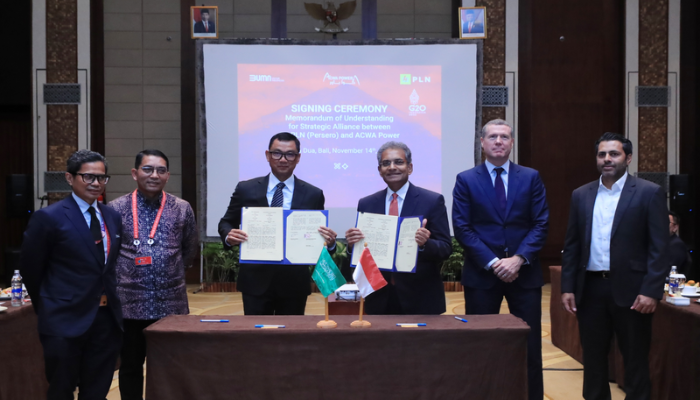In Indonesia, a state-owned power firm and ACWA Power will collaborate to look into prospective energy storage and green hydrogen projects.
Recently, ACWA Power, a Saudi Arabia-based developer and investor in renewable energy and infrastructure, announced the signing of a Memorandum of Understanding (MoU) with PT Perusahaan Listrik Negara (PLN), Indonesia’s sole electricity generator and monopoly distributor.
About two-thirds of Indonesia’s entire electric power production fleet, with a total portfolio of 65.5GW, is operated or owned by PLN, the nation’s sole buyer of energy produced by IPP assets.
The partnership between the two will look into several potential projects, including feasibility and other studies for a pumped hydro energy storage (PHES) facility at a 600MW to 800MW hydroelectric power plant, a potential 4GW battery energy storage system (BESS) project, and a facility for producing green hydrogen or ammonia that is powered by hydroelectricity.
While Mohammad Bin Salman Al Saud, the Crown Prince and Prime Minister of Saudi Arabia, was in Bali for the G20/B20 conference, the MoU was signed. The CEOs of ACWA Power and PLN were among the signatories, while the director general of electricity for Indonesia’s Ministry of Energy and Mineral Resources was there, along with other dignitaries and authorities.
Just a few weeks ago, ACWA Power joined the Indonesian market after PLN chose the developer to carry out two sizable floating solar PV (FPV) projects there with a combined investment value of US$105 million.
The two FPV projects will be owned by a PLN subsidiary with the remaining 51%, as was previously reported by our colleagues at PV Tech at the beginning of this month. At that time, Clive Turton, the chief investment officer of ACWA, called Indonesia “an interesting market” with “government backing for renewable energy, a grasp of global concerns, huge demand, and an urgent need to feed the country’s numerous population.”
Increasing power demand due to population growth
According to statistics from the Ministry of Energy and Mineral Resources, coal (37%) and petroleum (32%), along with 17% from natural gas, accounted for 69% of Indonesia’s primary energy consumption in 2020. The remaining sources, including hydroelectric (3%), include other sources, with only 4% coming from geothermal and non-hydroelectric renewables.
The nation has committed to reaching net zero emissions by 2060 or earlier and increasing the proportion of electricity produced by renewable sources to 23% by 2025.
According to a recent study by the International Renewable Energy Agency (IRENA), even though Indonesia’s population is expected to reach 335 million by 2050, the country could save money overall on energy costs and lessen the effects of externalities like air pollution by investing in making renewable energy account for two-thirds of its power mix.
According to to report data, PLN and Indonesia Battery Corporation (IBC), another state-owned business, inked an MoU in March to collaborate on the development of a 5MW BESS pilot project.
Large-scale renewable energy plus energy storage projects that will benefit the nearby city-state of Singapore may also find a home in Indonesia. In October of last year, PLN and Singapore’s Sembcorp Industries inked a memorandum of understanding (MoU) for a solar-plus-storage project on Indonesia’s Batam-Bintan-Karimun island region that would supply local power requirements as well as transport power to Singapore via a subsea cable.
To transport power back overseas, or in this case, under the sea, Sunseap, a second Singaporean company that specializes in creating renewable energy sources, plans to construct 7 GW of solar PV and 12 GWh of storage in another island region.
During the first half of 2022, ACWA Power recorded an operating income of SAR1,153 million (US$307.46 million), a 21% increase in profit over the same period last year.

